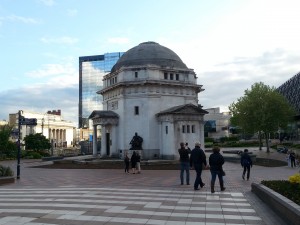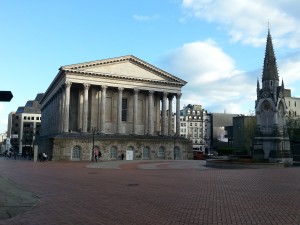The tour begins at Centenary Square, in the city center, close to most major hotels in Birmingham and a short walk from New Street station.
SIGHTS (Centenary Square / Hall of Memory): The Centenary square is today an extreme mix of new and slightly old, the oldest structures around the square being the Hall of Memory, Baskerville House and the former headquarters of the Birmingham Municipal Bank, all of which date from the 1920s and 1930s.

The building opposite Centenary Square – on the other side of Broad Street – was opened in 1933 as the HQ of the Birmingham Municipal Bank. This bank was unique in being the only one controlled by a local authority. The bank ceased to be a department of the city council in 1976, becoming instead a Trustee Savings Bank (TSB). The TSB later vacated the building on Broad Street, which was in 2006 sold to the Birmingham City Council, having been granted Grade II listed status in 1996. Since then it has seen occasional use as an arts and events venue. The future of the building is presently unclear. It is not open to the public except during scheduled events.
The Hall of Memory on the western side of Broad Street, was erected 1922-25 to commemorate the 12,320 Birmingham citizens who died in World War I.
Near the memorial is Baskerville House, completed in 1938 on a site originally occupied by the home of printer and type designer John Baskerville, inventor of the Baskerville typeface. Until 1998 it housed offices for parts of the Birmingham City Council, following which it stood vacant for a few years. It was refurbished 2003-2007 and is today a mixed office building.
SIGHTS (Library of Birmingham / ICC): Next to Baskerville House is the all new Library of Birmingham. It was opened to the public in 2013 by Nobel peace prize recipient Malala Yousafzai, in a building estimated to have cost £188.8 million. It is arguably the largest public library in Europe and the 10th most popular visitor attraction in the UK in 2014. The library itself contains a number of significant collections, including one of the most important Shakespeare collections in the world, held in the Shakespeare Memorial Room. On level 7 of the building is The Secret Garden, featuring stunning views of the Birmingham City Centre and beyond. Note that the library does not open until 11AM, due to a massive cut in opening hours in 2015 due to financial difficulties within the Birmingham City Council.
On the south side of the square is the International Convention Centre, built to a total cost of £200 million and opened in 1991 by Queen Elizabeth II. The foundation stone was laid in 1986 by then President of the European Commission, Jacques Delors, and the European Council also co-founded the construction of the building with almost £50 million. The centre has a total capacity of 8,000 delegates for conferences, and is also home to the 2,262 seat Symphony Hall. The building has an impressive atrium, with a few cafées and shops on the ground floor.
SIGHTS (Chamberlain Square / Town Hall): Walk past the Hall of Memory and through the Paradise Forum, which housed the Birmingham City Library until 2013. The building is due to be demolished, beginning in July 2015, so you have to hurry if you want to see this icon of brutalist architecture. On the other side of the Forum is Chamberlain Square, named after Joseph Chamberlain, Birmingham mayor (1873-1876), statesman and father of later Prime Minister Neville Chamberlain.
In the middle of the square is the Chamberlain Memorial, which was erected in his presence in 1880. The monument has been described as “an architectural scarecrow” and an “ungainly combination of shapes”, but in the opinion of Sights and Pints, there are many worse buildings and monuments in Birmingham. Fronting the square you will find the Birmingham Museum and Art Gallery (completed 1885 with an extension 1917) and Birmingham Town Hall (completed 1834).
In spite of its name, the Town Hall has never been a seat of local administration, but was custom built as a concert hall as the first significant work of the 19th century revival of Roman architecture. It houses a magnificent 6,000 pipe organ, originally installed by William Hill & Sons, and was refurbished for a cost of £35 million beginning in 1996.

